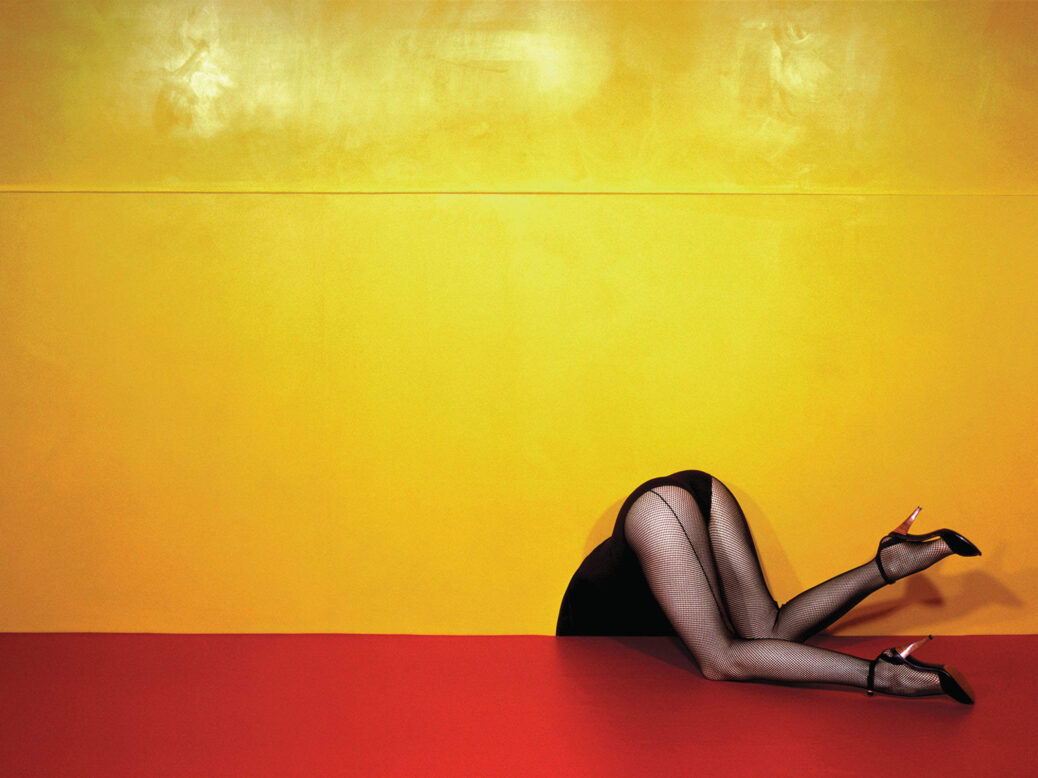
Guy Bourdin: Image Maker
Somerset House, London WC2
“Four people are sitting around a table, talking about baseball,” intoned Alfred Hitchcock at an American Film Institute seminar in 1970, describing an imaginary movie. “Suddenly a bomb goes off, blows the people to smithereens. What do the audience have? Ten seconds of shock.” But that would be “wasted footage”: far better, he said, to torment the viewer. “Take the same scene and tell the audience there’s a bomb under the table and it will go off in five minutes . . . Now the conversation about baseball becomes very vital.”
A Hitchcockian sensibility pervades the Guy Bourdin retrospective at Somerset House. Though the French fashion photographer’s domain was the pages of monthly magazines rather than the cinema screen, filmic suggestions of intrigue saturate his images of sex, death and danger. A boy stands in the shadows of a hotel room while to his left is a glowing TV set. Light falls on a pair of pink shoes at the foot of a bed; in those shoes is a woman, almost naked, her head cropped out entirely. It’s a deathly scene. It’s also a shoe advert for Charles Jourdan, shot in the spring of 1975.
Bourdin was the product of a Europe in upheaval. Born in Paris in 1928, he met the surrealist photographer Man Ray at the age of 22 and quickly became his protégé. After two years working as an artist, he struck up a relationship with Vogue Paris, which regularly published his photographs until 1987. Perhaps more than any of his contemporaries, Bourdin shaped our conception of glamour, introducing overt sexuality and suspense into what had previously been a decorative, flatly commercial discipline. He did so without ever truly abandoning his surrealist commitment to the conflicting impulses that our conscious minds clothe in the couture of civilisation. His work, like Man Ray’s, is emotive – yet exactly what it is that we feel remains ambiguous.
Bourdin revelled in such ambiguities in both his life and his art. He rarely gave interviews, seemingly happy to let rumour and speculation flourish. Did he really scavenge a dead bird from his garden and place it at a model’s feet, taking photographs of her as she cried? And did he cause a 20-year-old model to pass out when he covered her entire body with glue and pearls? Stories of a perfectionism that often bordered on cruelty adorn accounts of his working practices like baubles of fashion excess – but the work itself couldn’t be further from Zoolander-ish silliness. A seriousness of intent is apparent in each of his images, reinforced by this exhibition’s displays of his test Polaroids, meticulously cropped with black tape to reveal the most effective compositions within already fascinating scenes.
In a photograph from the 1970s, a female form is glimpsed through a doorway, her face obscured and her body contorted. Our eyes fall on her bra, then notice a man’s hand outside the room, pressing a light switch. The door is only partly ajar and the camera is positioned above head height; we peer at the tableau voyeuristically. But there is no resolution to the narrative. There’s no sex here, only the suggestion of it, and if the model’s outstretched position connotes some act of violence, it is merely implied. Yet we’re given enough information to feel compelled: the hand, the sordid-looking room, the faces hidden from view.
Part of what makes Bourdin’s work feel so glamorous despite the horror of many of his images is his fetishistic attention to detail. Our modern use of the word “glamour” carries with it an echo of its earlier connotations of magic and “delusive charm”, as the social historian Carol Dyhouse once put it. The world of glamour is one of fantasy and plays of light; it offers us a fiction of endless possibility that owes little subservience to rationality or natural laws. Fantasy, however, is more potent when grounded in relatable terms and Bourdin’s use of cinematic shorthand was just one strategy he employed: he also fixated on real-world clothes and accessories, amplifying their power to near-totemic heights. One Charles Jourdan commission enacts this sense of enlargement literally, showing a giant yellow shoe among ordinary-sized pairs.
At times, Bourdin’s camera seems to pursue textures for their sensual potency as an end in itself: in a 1970 Vogue shoot, the shiny beads that cover the face of a model compete for attention with the necklace she wears. It’s arguable that this celebration of materiality is an inadequate excuse for, say, his 1980 Pentax calendar image in which blood streams from a naked woman’s mouth – but the same dazzling control is present there and its affective quality is undeniable.
Bourdin’s seeming delight in female subjection may prove too unpalatable for some. Yet to dismiss his work for that alone is to misunderstand fashion – and art – as a sphere of didacticism. Bourdin was a manipulator of dreams. Condemning him for appealing to the extremities of our senses would be as puritanical as feeling ashamed of the darker contents of our own nightmares. Pasolini once said, “To scandalise is a right; to be scandalised, a pleasure.” At Somerset House, the pleasure was all mine.
Until 15 March 2015





